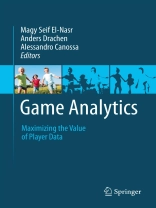Developing a successful game in today’s market is a challenging endeavor. Thousands of titles are published yearly, all competing for players’ time and attention. Game analytics has emerged in the past few years as one of the main resources for ensuring game quality, maximizing success, understanding player behavior and enhancing the quality of the player experience. It has led to a paradigm shift in the development and design strategies of digital games, bringing data-driven intelligence practices into the fray for informing decision making at operational, tactical and strategic levels.
Game Analytics – Maximizing the Value of Player Data is the first book on the topic of game analytics; the process of discovering and communicating patterns in data towards evaluating and driving action, improving performance and solving problems in game development and game research. Written by over 50 international experts from industry and research, it covers a comprehensive range of topics across more than 30 chapters, providing an in-depth discussion of game analytics and its practical applications.
Topics covered include monetization strategies, design of telemetry systems, analytics for iterative production, game data mining and big data in game development, spatial analytics, visualization and reporting of analysis, player behavior analysis, quantitative user testing and game user research. This state-of-the-art volume is an essential source of reference for game developers and researchers.
Key takeaways include:
- Thorough introduction to game analytics; covering analytics applied to data on players, processes and performance throughout the game lifecycle.
- In-depth coverage and advice on setting up analytics systems and developing good practices for integrating analytics in game-development and -management.
- Contributions by leading researchers and experienced professionals from the industry, including Ubisoft, Sony, EA, Bioware, Square Enix, THQ, Volition, and Playable Games.
- Interviews with experienced industry professionals on how they use analytics to create hit games.
विषयसूची
Foreword.- Part I – An Introduction to Game Analytics .- Introduction.- Game Analytics – The Basics.- Benefits of Game Analytics –Stakeholders, Contexts and Domains.- Game Industry Metrics Terminology and Analytics Case Study.- Interview with Jim Baer and Daniel Mc Caffery from Zynga.- Part II – Telemetry Collection and Tools.- Telemetry and Analytics Best Practices and Lessons Learned.- Game Development Telemetry in Production.- Interview with Nicholas Francis and Thomas Hagen from Unity Technologies.- Sampling for Game User Research.- Web Tics: A Web-based Telemetry and Metrics System for Small and Medium Games.- Interview with Darius Kazemi.- Part III – Game Data Analysis.- Game Data Mining.- Meaning in Gameplay: Filtering Variables, Defining Metrics, Extracting Features and Creating Models for Gameplay Analysis.- Gameplay Metrics in Game User Research: Examples from The Trenches.- Interview with Aki Järvinen from Digital Chocolate.- Better Game Experience through Game Metrics: A Rally Videogame Case Study.- Part IV – Metrics Visualization.- Spatial Game Analytics.- Visual Game Analytics.- Visual Analytics Tools: A Lens into Players’ Temporal Progression and Behavior.- Interview with Nicklas “Nifflas” Nygren.- Part V – Mixed Methods for Game Evaluation.- Contextualizing Data.- Combining Back-End Telemetry Data with Established User Testing Protocols: A Love Story.- Game Metrics through Questionnaires.- Interview with Simon Møller from Kiloo.- Visual Attention and Gaze Behavior in Games: An Object-based Approach.- An Introduction to Physiological Player Metrics for Evaluating Games.- Improving Gameplay with Game Metrics and Player Metrics.- Part VI – Analytics and Player Communities.- Data Collection in Massively Multiplayer Online Games: Methods, Analytic Obstacles, and Case Studies.- Designer, Analyst, Tinker: How Game Analytics Will Contribute to Science.- Interview with Ola Holmdahl and Ivan Garde from Junebud.- Part VII – Metrics and Learning.- Metrics in Simulations and Games for Learning.- Conceptually Meaningful Metrics: Inferring Optimal Challenge and Mindset from Gameplay.- Interview with Simon Egenfeldt Nielsen from Serious Games Interactive.- Part VIII – Metrics and Content Generation.- Metrics for Better Puzzles.
लेखक के बारे में
Magy Seif El-Nasr is an Associate Professor in the Colleges of Computer and Information Sciences and Arts, Media and Design, and the Director of Game Educational Programs and Research at Northeastern University, and she also directs the Game User Experience and Design Research Lab. Dr. Seif El-Nasr earned her Ph.D. degree from Northwestern University in Computer Science. Magy’s research focuses on enhancing game designs by developing tools and methods for evaluating and adapting game experiences. Her work is internationally known and cited in several game industry books, including Programming Believable Characters for Computer Games (Game Development Series) and Real-time Cinematography for Games . In addition, she has received several best paper awards for her work. Magy worked collaboratively with Electronic Arts, Bardel Entertainment, and Pixel Ante.
Anders Drachen is a veteran Data Scientist, currently operating as Lead Game Analyst for Game Analytics (www.gameanalytics.com). He is also affiliated with the PLAIT Lab at Northeastern University (USA) and Aalborg University (Denmark) as an Associate Professor, and sometimes takes on independent consulting jobs. His work in the game industry as well as in data and game science is focused on game analytics, business intelligence for games, game data mining, game user experience, industry economics, business development and game user research. His research and professional work is carried out in collaboration with companies spanning the industry, from big publishers to indies. He writes about analytics for game development on blog.gameanalytics.com, and about game- and data science in general on www.andersdrachen.wordpress.com. His writings can also be found on the pages of Game Developer Magazine and Gamasutra.com.
Alessandro Canossa is Associate Professor in the College of Arts, Media and Design at Northeastern University, he obtained a MA in Science of Communication from the University of Turin in 1999 and in 2009 he received his Ph D from The Danish Design School and the Royal Danish Academy of Fine Arts, Schools of Architecture, Design and Conservation. His doctoral research was carried out in collaboration with IO Interactive, a Square Enix game development studio, and it focused on user-centric design methods and approaches. His work has been commented on and used by companies such as Ubisoft, Electronic Arts, Microsoft, and Square Enix. Within Square Enix he maintains an ongoing collaboration with IO Interactive, Crystal Dynamics and Beautiful Games Studio.












